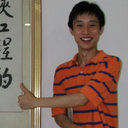About
9
Publications
6,247
Reads
How we measure 'reads'
A 'read' is counted each time someone views a publication summary (such as the title, abstract, and list of authors), clicks on a figure, or views or downloads the full-text. Learn more
34
Citations
Introduction
Freshman
Skills and Expertise
Additional affiliations
September 2019 - January 2024
September 2016 - April 2019
September 2012 - June 2016
Publications
Publications (9)
In this paper, a wideband filtering magnetoelectric (ME) dipole antenna without any extra filtering circuits is first proposed for millimeter-wave (MMW) applications. To improve the radiation efficiency, the printed ridge gap waveguide (PRGW) feeding network is employed. The proposed antenna mainly includes four parts: radiation patches, driven stu...
An evanescent quad-ridge antenna (EQA) fed by a compact transition is proposed in this letter for 5G millimeter-wave (mm-wave) phased-array applications. The EQA is realized by an evanescent-mode quad-ridged square waveguide (QRSW) filter with a cross-shaped slot as the radiator. The compact transition is designed by leveraging the coupling between...
A millimeter-wave (MMW) printed ridge gap waveguide (PRGW) fed filtering metasurface antenna (MSA) array is presented for 5G applications. The MSA element consists of a parasitic loop and a stacked patch. The elaborately designed parasitic loop around MSA not only provides satisfactory lower stopband performance but also brings an in-band resonance...
Integrating the sub-6 GHz antenna and the
millimeter-wave (mm-wave) antenna in one radiating aperture is
a promising approach to support different frequency bands for
the incoming communication system. In this paper, an mm-wave
dual-polarized 64-element phased-array antenna is integrated
into the partially reflective surface (PRS) of a sub-6 G...
In this letter, a three-stage high efficiency filtenna using the gap waveguide (GWG) technology is first proposed for 60 GHz applications. It is based on the bandpass filter theory to seamlessly integrate the high-order mode GWG cavity and the slot antenna, so that good filtering response and compact structure can be easily obtained. Besides, the T...
A high-gain dual-band resonant cavity antenna (RCA) for the fifth-generation (5G) millimeter wave (MMW) communications is presented in this letter. The proposed antenna provides the high gain and large gain-bandwidth product (GBP) over the 28 GHz band and the 38 GHz band. The heights of the second- and third-order resonant in the RCA are optimized...
Questions
Questions (8)
When perform a inverse Chirp-Z transform of a frequency domain signal (like S parameter measured in VNA).It's possible that we can observe the signal that is before zero second.Is this signal real?
As known,we can do measurements on the VNA(vector network analyzer )and get both real and image parts of the frequency-domain Scattering parameter,the signal(S(f)).Then we transform it to the time domain (S(t)).Usually we just keep the real part of the time-domain signal as we do in the DSP.But since Scattering parameter in frequency domain is a ratio of microwave signal that goes in and reflects out,and when it comes to time domain.Can the TD waveform still represent the ratio of signals in and out?Where does the phase part go?The actual waveform is absolutely not the TD signal from the DFT,that's sure,right?
To transform a band limited (f1~f2) frequency domain signal to time domain (0~Tmax).Chirp-z can do the transformation in the direction from time domain to a partial frequency domain,e.g. f1~f2 . So I wonder if I can perform an inverse CZT? Any help will be appriciated.
Hi everyone,
I've simulated a microstrip device using HFSS with RO4350.The ROGERS data sheet says the Er(relative dielectric constant)is 3.48.But the suggest Er in the software is 3.66.CST also says 3.66 is recommended but 3.48 is for specification.
After fabrication of my design,it turns out that the simulating with Er=3.48 results in a lower centre frequency(40MHz below 2.4GHz).Back to simulation,I change the substrate Er to 3.66,the result agrees well with the measurement.
One of the devices ,produced when I operate the a engraving machine incorrectly,suffered a greater erase depth.So the substrate is thinner. I assume that the effective Er is lower than 3.48.This one is right on my required centre frequency.I begin to find out that the value 3.66 is correct. I made a mistake.
Usually,this difference can be ignored.However in my work here a different Er comes to a different centre frequency.
So I get confused.I know that I should simulate using the recommended value 3.66.But I just want to know why.Why I should use 3.66 rather than 3.48.Does anybody know?please help me.
Hi,everyone,
Is there any good methods or tools for me to draw a geometry of a microstrip design in my dissertation?
Thanks a lot!
Hi,
How can I remove the phase loading effect of a simulated microstrip filter so that I can extract the poles of the admittance matrix of it?
Which paper or book should I refer to?
Thank you.
I use lumped port in in transient network analysis to replace the ones in frequency domain.
Error: Port refinement, process hf3d error: Port '2' is not a TEM port as required for transient analysis. (9:45:34 AM Mar 29, 2016)
"
Conference Paper Advanced Filter Tuning using Time Domain Transforms
I am working on extracting the coupling factor of microstrip open-loop resonator with a center frequency of 2.5 GHz.
Somehow I cannot find too peaks in S21 with which I can figure out the coupling coefficient,only in the ELECTRIC coupling case,the peaks appear around 5 Ghz instead.Is it common in some occasions?
I will later attach the HFSS project files (version 15) and a photograph of the layout if possible.Do I miss something important?
However,with the help of the HFSS Eignemode,too resonant frequencies can be found around 2.5 GHz.Is it accurate to extract coupling coefficients this way?













